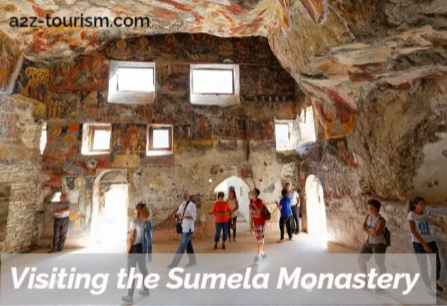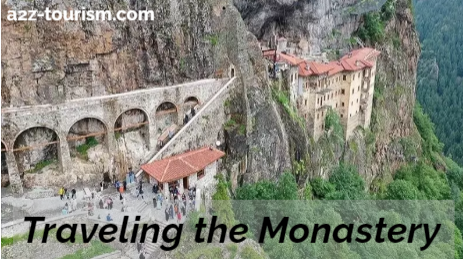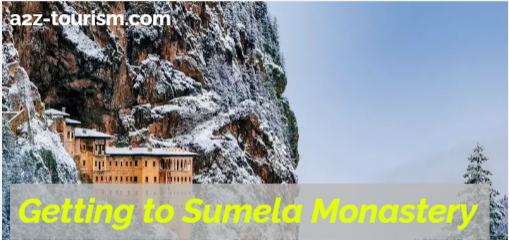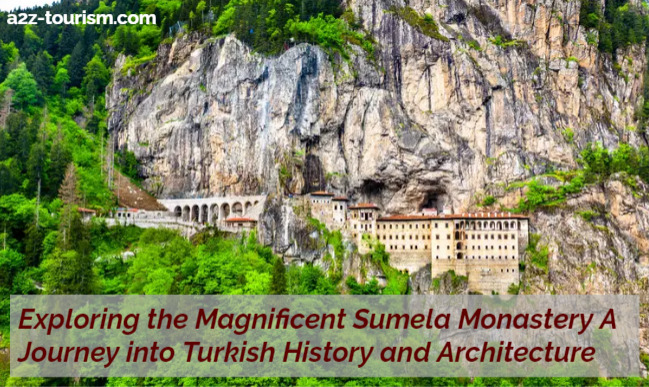Exploring the magnific Sumela Monastery A Journey into Turkish History and Architecture Nestled in the rugged escarpments of the Pontic Mountains in northeastern Turkey, the Sumela Monastery stands as a testament to the continuing spirit of Christian faith and architectural imagination. comprehended for its stunning position, rich history, and intricate oils, this friary has attained the fantasy of trippers, chroniclers, and art suckers for centuries. In this composition, we will claw into the history, edifice, and significance of the Sumela Monastery, probing its history, present, and future.
History of the Sumela Monastery
The Sumela Monastery, also known as the Monastery of Panagia Sumela or Panagia Soumela, has a history that dates back to the intricate period. According to tradition, it was innovated in the 4th-century announcement by two Athenian monks, Barnabas and Sophronius, who caught on a miraculous icon of the Virgin Mary in a near delve. This discovery led them to demonstrate the abbey as a place of hero worship and passage.
Over the centuries, the friary grew in size and significance, becoming a considerable religious and artistic epicenter in the region. It was specifically famed for its collection of religious bones and penmanship, as well as its business in conserving Greek Orthodox traditions and civilization during times of political fermentation.
The friary’s fortunes declined and flowed with the changing runs of record. It was damaged and rebuilt several times, most especially after the irruption of the Seljuk Turks in the 13th century and during the Ottoman menstruation. Despite these fusses, the friary continued to thrive, attracting pilgrims and scholars from far and wide.
Architecture and Design
One of the most conspicuous features of the Sumela Monastery is its architectural design, which is a mix of intricate, Georgian, and Armenian influences. The priory is erected into the sheer escarpments of the Pontic Mountains, dominating the Altındere Valley below. Its position not only provides a stirring background but similarly serves a practical purpose, proffering protection from raiders.
The hermitage complex is contained in several structures, including churches, sanctuaries, monks’ rooms, and a library. The most notable of these is the Rock Church, which is adorned with astonishing panoramas describing backgrounds from the Bible and the lives of saints. These oils, which date back to the 9th century, are considered some of the finest illustrations of intricate art in the world.
The friary’s armature isn’t only aesthetically pleasing but also reflects the imagination and skill of its builders. The use of original accouterments similar to gravestones and wood, as well as the integration of natural grottoes and gemstone conformations into the design, is a testament to the artificer of the time.
Significance and heritage
The Sumela Monastery holds immense denotation for both religious and artistic reasons. For centuries, it slaved as a place of passage for Christians, who came to deify the icon of the Virgin Mary and seek her supplication. It correspondingly played a pivotal part in conserving Greek Orthodox traditions and culture, specifically during times of persecution and oppression.
From an artistic eye view, the friary is a treasure trove of art and cadre, with its oils, icons, and calligraphies feeding inestimable perceptivity into the religious and cultural practices of the time. It’s also a symbol of the multilateral heritage of the field, reflecting the distant influences that shaped its record.

Visiting the Sumela Monastery
Today, the Sumela Monastery continues to attract callers from around the world, imaged by its honey, history, and spiritual significance. The friary has tasted expansive restoration work in recent times, allowing callers to explore its colorful structures and respect its art and armature over near.
To reach the friary, callers demand a hike up a steep path from the vale below, a trip that’s awarded with stirring lookouts and a sense of admiration at the sheer scale of the friary complex. Once outside, callers can explore the colorful structures, missions, and grottoes that make up the hermitage, as well as enjoy the tranquility and serenity of its surroundings.
History and Denotation
The Sumela Monastery, also known as the Panagia Soumela Monastery, has a rich history dating back to the intricate period. Constructed in the 4th-century announcement by Athenian monks Barnabas and Sophronios, the friary served as a spiritual retreat and religious center for Orthodox Christians over a thousand times. Despite enduring irruptions, wars, and natural disasters, the abbey has stood as a testament to the adaptability of its builders and the unvarying piety of its denizens.

Architecture and Construction
The armature of the Sumela Monastery is a witching mix of intricate and Anatolian styles, harmoniously integrated into the natural geography. Sculpted into the sheer escarpments of Altındere Valley, the friary complex comprises sanctuaries, dormitories, a library, a kitchen, and a dining hall connected by winding staircases and narrow passages. The construction of the friary was an emotional engineering feat, with professed crafters and sloggers strictly sculpturing the gravestone and elaborating the structures with intricate oils.

Traveling the Monastery
Today, the Sumela Monastery remains a crowd-pleasing destination for guests worldwide, drawn by its literal denotation, stunning armature, and spiritual air. Guided tenures offer an occasion to research the friary complex, respect the ancient oils, and claw into its rich artistic custom. The travel begins with a scenic hike through Altındere National Park, having callers enwrap themselves in the girding natural beauty. As they lift the crags, they’re awarded stirring lookouts of the vale below, brooding the stage for the admiration- bucking up sight that awaits.
Upon transferring to the abbey, drop-ins are saluted by the grand façade of the main church, adorned with intricate busts and colored oils depicting scenes from the lives of the Virgin Mary and Jesus Christ. outdoors, the dimly lit tabernacles and entries transude tranquility and reverence, bidding callers to reflect on the centuries of history that have unfolded within these ancient walls.
Preserving and conserving sweats
The Sumela Monastery faces proceeding challenges similar to undermining, surviving, and the impact of tourism. In recent times, significant sweats have been made to save and cover the friary and its surroundings. preservation moves, restoration systems and caller operation strategies have been enforced to ensure the life of this unique artistic heritage point. By walking a balance between preservation and making the friary accessible to callers, authorities aim to guard its heritage for unborn generations to appreciate and worship.
Construction of Sumela Monastery
The Sumela Monastery, also known as the Monastery of the Virgin Mary, is believed to have been innovated in the 4th-century announcement by two Athenian monks, Barnabas and Sophronius. According to legend, they discovered a miraculous icon of the Virgin Mary in a near-devest and decided to make a friary on the spot. Over the centuries, the friary passed several emendations and expansions, with the most significant construction taking place during the 13th century under the reign of Emperor Alexios III Komnenos.
The hermitage is fabricated into the sheer brilliant face of a precipice roughly 1,200 measures above ocean position, manufacturing it a conspicuous feat of medieval engineering. The establishment consists of several missions, an archive, a kitchen, pupil apartments, and an astonishing main tabernacle devoted to the Assumption of the Virgin Mary. The surface of the friary is adorned with various oils depicting scenes from the Bible and the biographies of saints, adding to its beauty and literal denotation.

Getting to Sumela Monastery
The Sumela Monastery is located near the city of Macka in the Trabzon fiefdom of Turkey. The nearest major megacity is Trabzon, which is roughly 47 kilometers down. Excursionsists can transfer Trabzon by strain, with the Trabzon Airport slaving as the main open sesame to the region. From Trabzon, the hermitage can be reached by road in about an hour, with several transportation options available, including motorcars, hacks, and rental buses.
Once in Macka, callers can reach the friary by following a well-pronounced hiking trail that leads up the precipice face to the entrance. The hike is more or less steep and can be burdensome, but the stunning lookouts along the way make it well worth the trouble. Alternately, there’s a string automobile that operates during the summer months, offering a more tardy ascent to the hermitage.

Exploring the Interior of Sumela Monastery
Upon entering the friary complex, callers are saluted by a series of narrow pathways and gravestone staircases that wind their way through the colorful structures. The main tabernacle is the focal point of the establishment, with its moving pate and beautiful oils covering the walls and ceilings. The church is still used for religious favors on special occasions and is a crowd-pleasing passage point for Orthodox Christians.
From the penthouse to the main temple, the hermitage complex correspondingly includes several minor bethels, each with its unique architectural style and embellishing rudiments. The most notorious of these is the Rock Church, which is sculptured directly into the precipice visage and features stunning oils dating back to the 9th century.
Fascinating Data About Sumela Monastery
- The name” Sumela” is allowed to be deduced from the Greek word” melas,” meaning” black,” due to the dark color of the jewels girding the friary.
- The friary was abandoned in 1923 following the population exchange between Greece and Turkey, but sweat to restore and save it began in the 1950s.
- Sumela Monastery is one of the most earthshaking complicated gravestones in Turkey and is listed as a UNESCO World Heritage Site.
Practical Information for Callers
- The friary is open to callers time-round, but it’s most fluently accessible during the summer months when the string auto is functional.
- Admission to the friary is free, but there’s a small figure for the string auto lift.
- Callers should wear comfortable shoes and be prepared for steep and uneven terrain.
- Photography is allowed inside the friary, but flash photography isn’t permitted in certain areas to cover the oils.
Conclusion
The Sumela Monastery stands as a testament to the dateless beauty and profound church that can be set up in Turkish history and armature. Its position perched on the escarpments of Altındere National Park, its remarkable intricate and Anatolian architectural emulsion, and its rich religious significance make it a witching destination for trippers from around the world. The friary’s preservation and conservation sweats are pivotal to ensure that unborn generations can continue to appreciate and be inspired by its nobility.
A visit to the Sumela Monastery is a trip into the heart of Turkish culture and heritage. As callers explore the friary complex, they’re transported back in time, marveling at the intricate oils, wandering through its winding passages, and absorbing the peaceful air that permeates the halls. The combination of natural beauty, literal significance, and architectural splendor creates an experience that’s both admiration- inspiring and demeaning, leaving a lasting print on all who have the honor to visit.
The Sumela Monastery is a true treasure of Turkish history and armature. Its majesty and spiritual air continue to allure and inspire callers, offering a profound connection to the history and a regard into the rich shade of Turkish culture. By conserving and guarding this remarkable point, we can ensure that its heritage endures, allowing unborn generations to embark on their peregrinations into the witching world of the Sumela Monastery.
FAQs
Why was Sumela Monastery abandoned?
The Sumela Monastery was abandoned in 1923 due to a combination of factors. After the fall of the intricate Conglomerate in 1453, the friary came under the control of the Ottoman Empire. Over the centuries, it looked like chromatic demurrals, including temblors and holocausts. still, the final blow came in 1923 when the population exchange between Greece and Turkey took place. The friary’s Greek Orthodox monks were forced to leave, and it was left vacant and fell into seediness.
Is Sumela Monastery worth seeing?
Yes, the Sumela Monastery is surely worth visiting. Despite existing delivery, it remains a remarkable artistic and literal point. The abbey’s edifice, perched on the barrancas, offers stirring views of the compassing geography. The inside of the friary features beautiful oils and religious vestiges. also, the natural eyeful of the area, with its prosperous timbers and scenic ground, adds to the across-the-board experience. It’s a du jour rubberneck magnet in Turkey.
How do you get up to the Sumela Monastery?
To reach the Sumela Monastery, callers need to travel to Trabzon, Turkey. From there, they can take a machine or drive to the nearby city of Macka. From Macka, there’s a well-pronounced road that leads to the entrance of the friary. still, please note that due to the grueling terrain and steep escarpments, reaching the factual friary requires a hike uphill. The hike can live physically calling, so it’s historic to wear felicitous footwear and be readied for the trip.
Who confected Sumela Monastery?
The Sumela Monastery was erected by Greek Orthodox monks in the 4th century announcement. It’s believed to have been constructed by two Athenian preachers, Barnabas and Sophronios. The hermitage was devoted to the Virgin Mary and slaved as a place of deification, contemplation, and erudite exercise for the monks.
Which is the oldest friary in the world?
The title of the oldest friary in the world is a subject of debate and depends on how one defines a friary. still, one of the oldest continuously performing cloisters is generally considered to be the Monastery of Saint Anthony in Egypt. It’s believed to have been innovated in the 4th century announcement by Saint Anthony, a prominent figure in early Christian monasticism.
Who erected cloisters and why?
Cloisters were generally erected by religious communities or orders, similar to monks or nuns, who sought to live a reflective and devout life devoted to their faith. Monasticism cropped in colorful religious conventions, including Christianity, Buddhism, and Islam. The reasons for confecting cloisters varied depending on the specific religious beliefs and practices. Some common or garden provocations embraced seeking bodiless enlightenment, rehearsing asceticism, conserving sacred training, feeding a place for deification and religious rituals, and serving as centers for schooling, handcraft, and beneficent exercise within the neighborhood.

